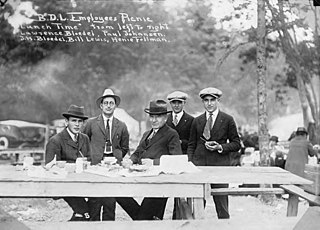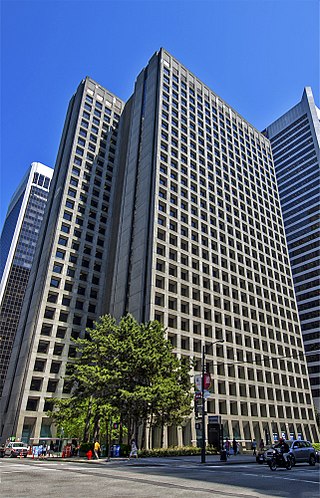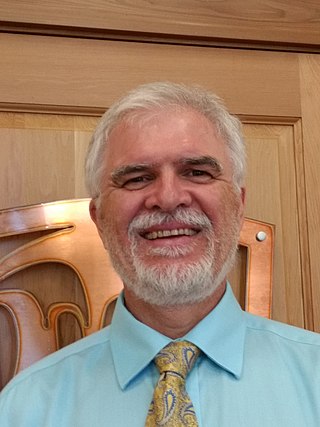
Clayoquot Sound is located on the west coast of Vancouver Island in the Canadian province of British Columbia. It is bordered by the Esowista Peninsula to the south, and the Hesquiaht Peninsula to the North. It is a body of water with many inlets and islands. Major inlets include Sydney Inlet, Shelter Inlet, Herbert Inlet, Bedwell Inlet, Lemmens Inlet, and Tofino Inlet. Major islands include Flores Island, Vargas Island, and Meares Island. The name is also used for the larger region of land around the waterbody.
The Weyerhaeuser Company is an American timberland company which owns nearly 12,400,000 acres of timberlands in the U.S., and manages an additional 14,000,000 acres of timberlands under long-term licenses in Canada. The company has manufactured wood products for over a century. It operates as a real estate investment trust (REIT).
PotlatchDeltic Corporation is an American diversified forest products company based in Spokane, Washington.

Julius Harold Bloedel was an American businessman and entrepreneur who operated primarily in the Pacific Northwest region of the United States and Canada.

Powell River is a city on the northern Sunshine Coast of southwestern British Columbia, Canada. Most of its population lives near the eastern shores of Malaspina Strait, which is part of the larger Georgia Strait between Vancouver Island and the Mainland. With two intervening long, steep-sided fjords inhibiting the construction of a contiguous road connection with Vancouver to the south, geographical surroundings explain Powell River's remoteness as a community, despite relative proximity to Vancouver and other populous areas of the BC Coast. The city is the location of the head office of the qathet Regional District.
Crofton is a small west coast town within the District of North Cowichan of southern Vancouver Island in British Columbia, east of BC Highway 1 about 74 kilometres (46 mi) north of Victoria.

The BC Forest Discovery Centre, located in Duncan, chronicles the history of logging in British Columbia, Canada. It is a 100-acre (40 ha) site with 2.5 km of operational 3 ft narrow gauge railway.

Carmanah Walbran Provincial Park, originally Carmanah Pacific Provincial Park, is a remote wilderness park located inside traditional Ditidaht First Nation ancestral territory. The park covers a land area of 16,450 ha (63.5 sq mi) immediately adjacent to Pacific Rim National Park Reserve's West Coast Trail on the south-western, coastal terrain of Vancouver Island. The provincial park comprises the entire drainage of Carmanah Creek, and a good portion of the lower Walbran River drainage, both of which independently empty into the Pacific Ocean. The park is named after the Anglicized diitiid?aatx word kwaabaaduw7aa7tx, or Carmanah, meaning "thus far upstream" and John Thomas Walbran, a colonial explorer and ship's captain. Access to the park is by gravel logging road from Port Alberni, Lake Cowichan, or Port Renfrew.

MacMillan Provincial Park is a 301-hectare (740-acre) provincial park in British Columbia, Canada. Located 25 km (16 mi) west of Qualicum Beach and 16 km (9.9 mi) east of Port Alberni, the park straddles Highway 4 and the Island Rail Corridor in central Vancouver Island. It is nestled on the western shore of Cameron Lake, and protects the delta of the Cameron River. The park is home to a famous, 157-hectare (390-acre) stand of ancient Douglas fir, known as Cathedral Grove, which draws visitors from all over the world. The park provides the only highway-accessible protected old-growth Douglas-fir forest in British Columbia. In 2007 Cathedral Grove made the short list on CBC's competition Seven Wonders of Canada.

Catalyst Paper Corporation is a pulp and paper company based in Richmond, British Columbia. It operates five pulp mills and paper mills, producing a combined 1.8 million tonnes of paper and 491,000 tonnes of market pulp annually. The mills mostly produce magazine paper and newsprint.
Variable retention is a relatively new silvicultural system that retains forest structural elements for at least one rotation in order to preserve environmental values associated with structurally complex forests.
Island Timberlands LP, a private timberlands business in British Columbia, Canada, was created in 2005 by the purchase of lands from Weyerhaeuser's coastal BC timber estate, which had originally been purchased in 1999 from MacMillan Bloedel. The private managed forest lands comprise approximately 254,000 hectares of forests, both mature and regenerating. The majority of timber harvested from these lands is shipped to overseas clients as unprocessed logs.

The Clayoquot protests, also called the War in the Woods, were a series of blockades related to clearcutting in Clayoquot Sound, British Columbia. They culminated in mid-1993, when 856 people were arrested. The blockades in the summer of 1993 against logging of the temperate rainforest were the largest act of civil disobedience in Canadian history until the 2021 Fairy Creek blockades.
Stand.earth is a grassroots environmental organization founded in 2000. The organization protects endangered forests by transforming corporate policy and governmental laws in the United States and Canada. Stand.earth uses public education, advocacy, protest, negotiation and non-violent direct action tactics to achieve its goals.

Tzeporah Berman is a Canadian environmental activist, campaigner and writer. She is known for her role as one of the organizers of the logging blockades in Clayoquot Sound, British Columbia in 1992–93.

Port Alberni Mill is a paper mill located in the Canadian town of Port Alberni, British Columbia, on the edge of the Alberni Inlet. Part of Paper Excellence, the mill has two paper machines which produce 336,000 tonnes. Port Alberni Mill produces directory, lightweight coated paper, and specialty papers. The mill's papers are used in telephone directories, catalogues, magazines, brochures, inserts, flyers, and in food grade applications. The mill has 310 employees as of 2020.

Powell River Mill was a pulp mill and paper mill located in the Canadian town of Powell River, British Columbia. Part of Catalyst Paper, the mill has three paper machines which produce 469,000 tonnes of newsprint and uncoated fine paper. The mill had 441 employees as of 2014.

The MacMillan Bloedel Building is a 27-storey office tower in Vancouver, British Columbia. The building was constructed as the head office of the forestry company MacMillan Bloedel and was designed by Erickson/Massey Architects with Francis Donaldson. The partner-in-charge of design was Arthur Erickson, who conceived the building in 1965. Construction began in October 1966 and the building opened officially on 13 December 1968. The building is one of the earliest works in Erickson's catalogue and is one of Canada's outstanding examples of brutalist architecture. In 2021 the owners renamed the building Arthur Erickson Place, however, the original name remains in common use.

Jack Woodward is a Canadian lawyer. He specializes in Canadian Aboriginal law and is the author of Aboriginal Law in Canada, which is considered the leading Canadian publication on Aboriginal Law.

Mount Arrowsmith Biosphere Region (MABR) is a UNESCO Biosphere Reserve located on the east coast of Vancouver Island in British Columbia, Canada. It was designated in 2000 by UNESCO to protect a large second-growth coast Douglas fir ecosystem in the watersheds of the Little Qualicum and Englishman Rivers from being developed.

















